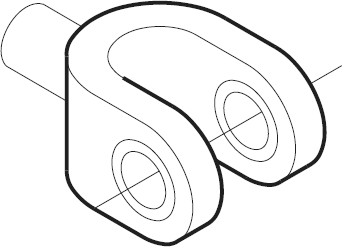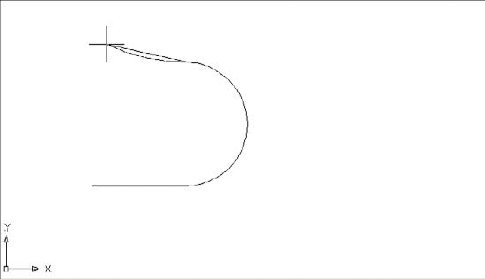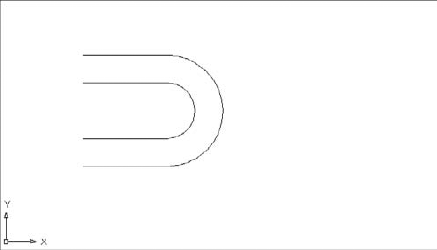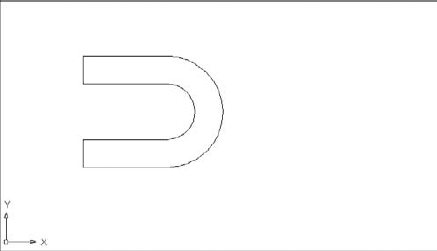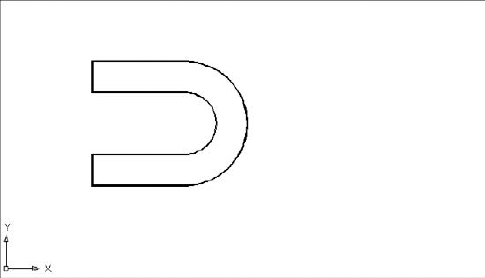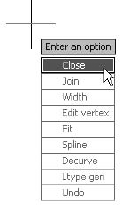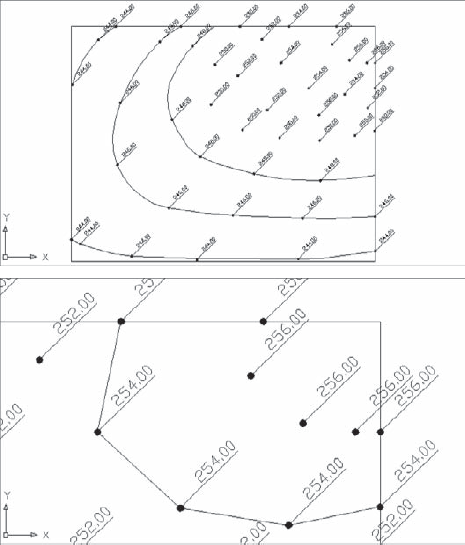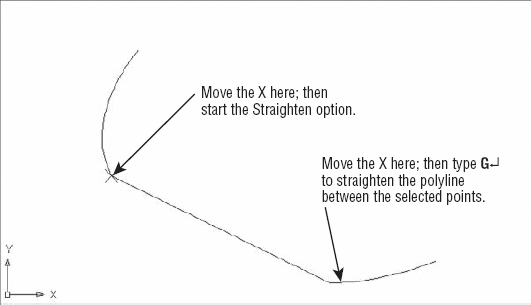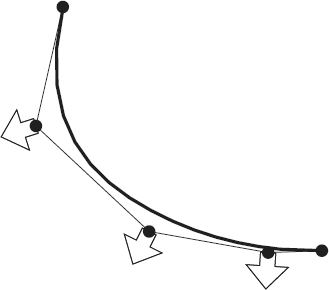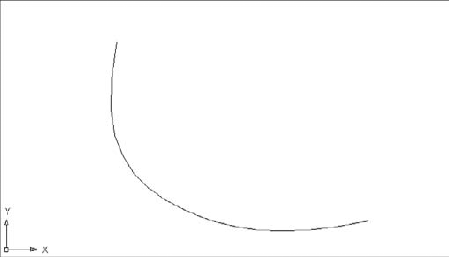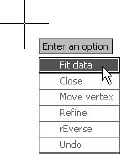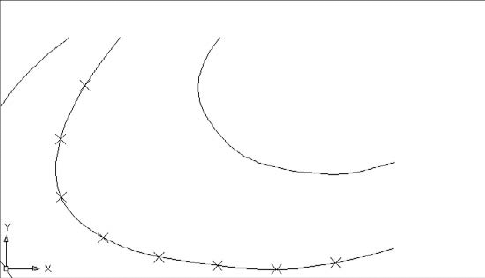So far in this book, you've been using basic lines, arcs, and circles to create your drawings. Now it's time to add polylines and spline curves to your repertoire. Polylines offer many options for creating forms, including solid fills and free-form curved lines. Spline curves are perfect for drawing accurate and smooth nonlinear objects.
In this chapter, you'll learn to do the following:
Create and edit polylines
Create a polyline spline curve
Create and edit true spline curves
Mark divisions on curves
Polylines are like composite line segments and arcs. A polyline may look like a series of line segments, but it acts like a single object. This characteristic makes polylines useful for a variety of applications, as you'll see in the upcoming exercises.
First, to learn about the polyline, you'll begin a drawing of the top view of the joint shown in Figure 19.1.
Follow these steps to draw the joint:
Open a new file, and save it as
Joint2d. Don't bother to make special setting changes because you'll create this drawing with the default settings.From the View tab's Navigate panel, choose All from the Zoom flyout or type Z


At the
Specify start point:prompt, enter a point at coordinate 3,3 to start your polyline.At the
Specify next point or [Arc/Halfwidth/Length/Undo/Width]:prompt, enter @3<0
At the
Specify next point or [Arc/Close/Halfwidth/Length/Undo/Width]:prompt, enter A
At the prompt
Specify endpoint of arc or [Angle/CEnter/CLose/Direction/Halfwidth/Line/Radius/Second pt/Undo/Width]:
enter @4<90

To continue the polyline with another line segment, enter L

At the
Specify next point or [Arc/Close/Halfwidth/Length/Undo/Width]:prompt, enter @3<180
Press

You now have a sideways, U-shaped polyline that you'll use in the next exercise to complete the top view of your joint.
Let's take a break from the tutorial to look at some of the options in the Polyline prompt that you didn't use:
- Close
Draws a line segment from the last endpoint of a sequence of lines to the first point picked in that sequence. This works exactly like the Close option for the Line command.
- Length
Enables you to specify the length of a line that will be drawn at the same angle as the last line entered.
- Halfwidth
Creates a tapered line segment or an arc by specifying half its beginning and ending widths (see Figure 19.3).
- Width
Creates a tapered line segment or an arc by specifying the full width of the segment's beginning and ending points.
- Undo
Deletes the last line segment drawn.
If you want to break a polyline into simple lines and arcs, you can use the Explode option on the Modify panel, just as you would with blocks. After a polyline is exploded, it becomes a set of individual line segments or arcs.
To turn off the filling of solid polylines, open the Options dialog box and click the Display tab. Clear the Apply Solid Fill check box in the Display Performance group.
You can edit polylines with many of the standard editing commands. To change the properties of a polyline, click the polyline to select it, right-click, and select Properties to open the Properties palette. You can use the Stretch command on the Modify panel to move vertices of a polyline. The Trim, Extend, and Break commands on the Modify panel also work with polylines.
In addition, many editing capabilities are offered only for polylines. For instance, later in this section you'll see how to smooth out a polyline by using the Fit option in the Pedit command.
In this exercise, you'll use the Offset command on the Modify panel to add the inside portion of the joint:

At the
Specify offset distance or [Through/Erase/Layer] <THROUGH>:prompt, enter 1.At the
Select object to offset or [Exit/Undo]<exit>:prompt, pick the U-shaped polyline you just drew.At the
Specify point on side to offset or [Exit/Multiple/Undo] <Exit>:prompt, pick a point on the inside of the U shape. You'll see a concentric copy of the polyline appears (see Figure 19.4).Press

The concentric copy of a polyline made by choosing the Offset tool can be useful when you need to draw complex parallel curves like the ones in Figure 19.5.
Next, complete the top view of the joint. To do this, you'll use the Edit Polyline tool, otherwise known as the Pedit command:
Connect the ends of the polylines with two short line segments (see Figure 19.6).

At the
Select polyline or [Multiple]:prompt, pick the outermost polyline.At the prompt
Enter an option [Close/Join/Width/Edit vertex/Fit/Spline/Decurve/Ltypegen/Undo]:
enter J

At the
Select objects:prompt, select all the objects you've drawn so far.Press

Press

Click the drawing to expose its grips. The entire object is highlighted, indicating that all the lines have been joined into a single polyline.
By using the Width option under Edit Polyline, you can change the thickness of a polyline. Let's change the width of your polyline to give some thickness to the outline of the joint. To do this, you'll use the Edit Polyline tool again, but this time you'll use a shortcut:
In most cases, you can simply double-click on a polyline to start the Pedit command. But if you want to edit multiple polylines or if you want to convert an object or set of objects into a polyline, use the Edit Polyline tool from the Modify panel to start Pedit.
Here's a brief look at a few of the Pedit options you didn't try firsthand:
- Close
Connects the two endpoints of a polyline with a line segment. If the polyline you selected to be edited is already closed, this option changes to Open.
- Open
Removes the last segment added to a closed polyline.
- Spline/Decurve
The Spline option smoothes a polyline into a spline curve (discussed in detail later in this chapter). The Decurve option changes a spline polyline back into its original shape before the Spline option was applied.
- Edit Vertex
Lets you edit each vertex of a polyline individually (discussed in detail later in this section).
- Fit
- Ltype Gen
Controls the way noncontinuous linetypes pass through the vertices of a polyline. If you have a fitted or spline curve with a noncontinuous linetype, turn on this option.
You can create a curve in AutoCAD in many ways. If you don't need the representation of a curve to be accurate, you can use a polyline curve. In the following exercise, you'll draw a polyline curve to represent a contour on a topographical map:
Open the
topo.dwgfile. The first image in Figure 19.9 contains the drawing of survey data. Some of the contours have already been drawn in between the data points.Zoom in to the upper-right corner of the drawing so your screen displays the area shown in the second image in Figure 19.9.

Press

Next you'll convert the polyline you just drew into a smooth contour line. Double-click the contour line you just drew.
At the prompt
Enter an option [close/Join/Width/Edit vertex/Fit/Spline/Decurve/Ltype gen/Undo]:
type F

Press

Your contour is now complete. The Fit option under the Pedit command causes AutoCAD to convert the straight-line segments of the polyline into arcs. The endpoints of the arcs pass through the endpoints of the line segments, and the curve of each arc depends on the direction of the adjacent arc. This gives the effect of a smooth curve. Next you'll use this polyline curve to experiment with some of the editing options unique to the Pedit command.
One of the Pedit options that I haven't yet discussed, Edit Vertex, is like a command within a command. Edit Vertex has numerous suboptions that enable you to fine-tune your polyline by giving you control over individual vertices.
To access the Edit Vertex options, follow these steps:
Turn off the Data and Border layers to hide the data points and border.
Double-click the polyline you just drew.
Type E

When using Edit Vertex, you must be careful about selecting the correct vertex to be edited. Edit Vertex has six options. You often have to exit the Edit Vertex operation and use Pedit's Fit option to see the effect of several Edit Vertex options on a curved polyline.
After you enter the Edit Vertex mode of the Pedit command, you can perform the following functions:
These functions are presented in the form of the following prompt:
[Next/Previous/Break/Insert/Move/Regen/Straighten/Tangent/Width/eXit] <N>:
The following sections examine each of the options in this prompt, starting with Next and Previous.
The Next and Previous options let you select a vertex for editing. When you start the Edit Vertex option, an X appears on the selected polyline to designate its beginning. As you select Next or Previous, the X moves from vertex to vertex to show which one is being edited. Let's try this:
Press

Type P

The Break option breaks the polyline between two vertices:
Position the X on one end of the segment you want to break.
Enter B

At the
Enter an option [Next/Previous/Go/eXit] <N>:prompt, use Next or Previous to move the X to the other end of the segment to be broken.When the X is in the proper position, enter G

You can also use the Break and Trim options on the Modify panel to break a polyline anywhere, as you did when you drew the toilet seat in Chapter 3.
Next, try the Insert option, which inserts a new vertex:
Type X

Type E

Press

Enter I

When the prompt
Specify location for new vertex:appears, along with a rubber-banding line originating from the current X position (see Figure 19.11), pick a point indicating the new vertex location. The polyline is redrawn with the new vertex.
Notice that the inserted vertex appears between the currently marked vertex and the next vertex, so the Insert option is sensitive to the direction of the polyline. If the polyline is curved, the new vertex won't immediately be shown as curved. (See the first image in Figure 19.12.) You must smooth it out by exiting the Edit Vertex option and then using the Fit option, as you did to edit the site plan. (See the second image in Figure 19.12.) You can also use the Stretch command (on the Modify panel) to move a polyline vertex.
In this brief exercise, you'll use the Move option to move a vertex:
Undo the inserted vertex by exiting the Edit Vertex option (enter X

Restart the Edit Vertex option, and use the Next or Previous option to place the X on the vertex you want to move.
Enter M

When the
Specify new location for marked vertex:prompt appears, along with a rubber-banding line originating from the X (see the first image in Figure 19.13), pick the new vertex. The polyline is redrawn (see the second image in Figure 19.13). Again, if the line is curved, the new vertex appears as a sharp angle until you use the Fit option (see the final image in Figure 19.13).

Figure 19.13. Picking a new location for a vertex with the polyline before and after the curve is fitted
You can also move a polyline vertex by using its grip.
In some cases, the effect of an option does not appear in the drawing immediately. You can use the Regen option to update the display of the polyline and see any changes you've made up to that point.
The Straighten option straightens all the vertices between two selected vertices. Using the Straighten option is a quick way to delete vertices from a polyline, as shown in the following exercise:
Undo the moved vertex (from the previous exercise).
Start the Edit Vertex option again, and select the starting vertex for the straight line.
Enter S

At the
Enter an option [Next/Previous/Go/eXit] <N>:prompt, move the X to the location for the other end of the straight-line segment.After the X is in the proper position, enter G

The Tangent option alters the direction of a curve on a curve-fitted polyline:
Undo the straightened segment from the previous exercise.
Restart the Edit Vertex option, and position the X on the vertex you want to alter.
Enter T

Point the rubber-banding line in the direction of the new tangent, and click the mouse. An arrow appears, indicating the new tangent direction. (See the second image in Figure 19.15.)
Don't worry if the polyline shape doesn't change. You must use Fit to see the effect of Tangent. (See the final image in Figure 19.15.)
Finally, you'll try the Width option. Unlike the Pedit command's Width option, the Edit Vertex/Width option enables you to alter the width of the polyline at any vertex. Thus you can taper or otherwise vary polyline thicknesses. Try these steps:
Undo the tangent arc from the previous exercise.
Return to the Edit Vertex option, and place the X at the beginning vertex of a polyline segment you want to change.
Type W

At the
Specify starting width for next segment <0.0000>:prompt, enter a value—12, for example—indicating the polyline width desired at this vertex.At the
Specify ending width for next segment <12.0000>:prompt, enter the width—24, for example—for the next vertex.
The width of the polyline changes to your specifications (see Figure 19.16).
The Width option is useful when you want to create an irregular or curved area in your drawing that is to be filled in solid. This is another option that is sensitive to the polyline direction.
As you've seen throughout these exercises, you can use the Undo option to reverse the last Edit Vertex option used. You can also use the Exit option to leave Edit Vertex at any time. Enter X
Enter an option [Close/Join/Width/Edit vertex/Fit/Spline/Decurve/Ltypegen/Undo]:
The Pedit command's Spline option (named after the spline tool used in manual drafting) offers you a way to draw smoother and more controllable curves than those produced by the Fit option. A polyline spline doesn't pass through the vertex points as a fitted curve does. Instead, the vertex points act as weights pulling the curve in their direction. The polyline spline touches only its beginning and end vertices. Figure 19.17 illustrates this concept.
A polyline spline curve doesn't represent a mathematically true curve. See the next section, "Using True Spline Curves," to learn how to draw a more accurate spline curve.
Let's see how using a polyline spline curve may influence the way you edit a curve:
Undo the width changes you made in the previous exercise.
To change the contour into a polyline spline curve, double-click the polyline to be curved.
At the
Enter an option [Close/Join/Width/Edit vertex/Fit/Spline/Decurve/Ltypegen/Undo]:prompt, enter S
Press

The curve takes on a smoother, more graceful appearance. It no longer passes through the points you used to define it. To see where the points went and to find out how spline curves act, do the following:
Click the curve. The original vertices appear as grips. (See the first image in Figure 19.19.)
Click the grip that is second from the top of the curve, as shown in the first image in Figure 19.19, and move the grip around. The curve follows your moves, giving you immediate feedback on how it will look.
Pick a point as shown in the second image in Figure 19.19. The curve is now fixed in its new position, as shown in the bottom image of Figure 19.19.
So far, you've been working with polylines to generate spline curves. The advantage of using polylines for curves is that they can be enhanced in many ways. You can modify their width, for instance, or join several curves. But at times, you'll need a more exact representation of a curve.
The spline objects are true Non-Uniform Rational B-Splines (NURBS) curves. A full description of NURBS is beyond the scope of this book, but basically, NURBS are a standard mathematical form used to represent shapes.
To create a spline curve, follow the steps described here. You don't have to do them now. Make a note of this section, and refer to it when you need to draw and edit a spline:

At the
Specify first point or [Object]:prompt, select a point to start the curve. (See Figure 19.20.) The prompt changes toSpecify next point:.Continue to select points until you've entered all the points you need. As you pick points, a curve appears, and it bends and flows as you move your cursor.
After you've selected the last point, press

If you press

Press

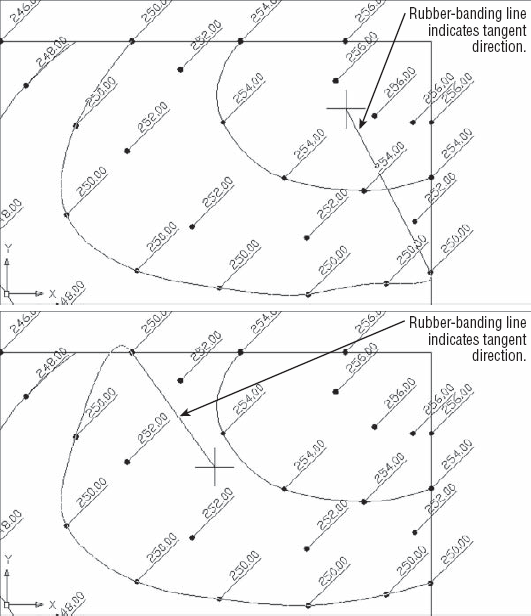
Figure 19.21. The last two prompts of the Spline command let you determine the tangent direction of the spline.
You now have a smooth curve that passes through the points you selected. These points are called the control points. If you click the curve, you'll see the grips appear at the location of these control points, and you can adjust the curve by clicking the grip points and moving them. (You may need to turn off the Data layer to see the grips clearly.)
You may have noticed two other options—Fit Tolerance and Close—as you were selecting points for the spline in the previous exercise. Here is a description of these options:
- Fit Tolerance
Lets you change the curve so that it doesn't pass through the points you pick. When you select this option, you get the prompt
Specify fit tolerance <0.0000>. Any value greater than 0 causes the curve to pass close to, but not through, the points. A value of 0 causes the curve to pass through the points.- Close
Lets you close the curve into a loop. If you choose this option, you're prompted to indicate a tangent direction for the closing point.
Spline curves are different from other types of objects, and many of the standard editing commands won't work on splines. AutoCAD offers the Edit Spline option, otherwise known as the Splinedit command, in the Home tab's expanded Modify panel for making changes to splines.
The Fit Data option of the Splinedit command lets you adjust the tangency of the beginning and endpoints, add new control points, and adjust spline tolerance settings. To get to these options, follow these steps:

At the
Select spline:prompt, select the spline you drew in the previous exercise.At the
Enter an option [Fit data/Close/Move vertex/Refine/rEverse/Undo]:prompt, type F
At the
[Add/Close/Delete/Move/Purge/Tangents/toLerance/eXit] <eXit>:prompt, enter the option you want to use. For example, to change the tangency of the first and last points of your spline, type t
The Refine option of the Splinedit command lets you control the pull exerted on a spline by an individual control point.
If you prefer, you can double-click on a spline to start the Splinedit command instead of selecting the Edit Spline tool in the Modify panel. If you have the Dynamic Input feature turned on, you can select Splinedit options from a menu that appears at the cursor (Figure 19.22) instead of typing in the option keyboard shortcuts.
Table 19.1. The Fit Data Options of the Splinedit Command
Function | |
|---|---|
Add | |
Close | Lets you close the spline into a loop |
Delete | Removes a control point from the spline |
Move | Lets you move a control point |
Purge | Deletes the fit data of the spline, thereby eliminating the Fit Data option for the purged spline |
Tangents | Lets you change the tangency of the first and last points |
toLerance | Controls the distance between the spline and a control point |
The Fit Data option of the Splinedit command offers many ways to edit a spline. However, this option isn't available to all spline curves. When you invoke certain other Splinedit options, a spline curve loses its fit data, thereby disabling the Fit Data option. These operations are as follows:
Fitting a spline to a tolerance (Spline/Fit Tolerance) and moving its control vertices.
Fitting a spline to a tolerance (Spline/Fit Tolerance) and opening or closing it.
Refining the spline.
Purging the spline of its fit data by using the Purge option of the Splinedit command. (Choose Edit Spline from the expanded Modify panel, or enter Splinedit

Also note that the Fit Data option isn't available when you edit spline curves that were created from polyline splines. See the sidebar "Turning Objects into Polylines and Polylines into Splines" earlier in this chapter.
If you'd like to learn more about the Splinedit options, check the AutoCAD Help window. It offers a detailed description of how these options work.
Perhaps one of the most difficult things to do in manual drafting is to mark regular intervals on a curve. AutoCAD offers the Divide and Measure commands to help you perform this task with speed and accuracy.
You can find the Divide and Measure tools on the expanded Draw Ribbon panel, as shown in Figure 19.23. Click the title bar of the Draw panel, and then click the flyout arrowhead shown next to the Point tool to open the flyout.

Figure 19.23. The Divide and Measure tools are in the expanded Draw Ribbon panel on the Point tool flyout.
The Divide and Measure commands are discussed here in conjunction with polylines, but you can use these commands on any object except blocks and text.
Use the Divide command to divide an object into a specific number of equal segments. For example, suppose you need to mark off the contour you've been working on in this chapter into nine equal segments. One way to do this is to first find the length of the contour by using the List command and then sit down with a pencil and paper to figure out the exact distances between the marks. But there is another, easier way.
The Divide command places a set of point objects on a line, an arc, a circle, or a polyline, marking off exact divisions. The following exercise shows how it works:
Open the
19a-divd.dwgfile. This file is similar to the one you've been working with in the previous exercises.Click the Point flyout in the expanded Draw panel and select Divide, or type Div

At the
Select object to divide:prompt, pick the spline contour line that shows Xs in Figure 19.24.The
Enter the number of segments or [Block]:prompt that appears next is asking for the number of divisions you want on the selected object. Enter 9
The Command prompt returns, and it appears that nothing has happened. But AutoCAD has placed several points on the contour that indicate the locations of the nine divisions you requested. To see these points more clearly, continue with the exercise.
Type DDPTYPE

Click the X point style at the upper-right corner of the dialog box, click the Set Size Relative To Screen radio button, and then click OK.
If the Xs don't appear, enter Re

You can also change the point style by changing the Pdmode system variable. When Pdmode is set to 3, the point appears as an X.
The Divide command uses point objects to indicate the division points. You create point objects by using the Point command. They usually appear as dots. Unfortunately, such points are nearly invisible when placed on top of other objects. But, as you've seen, you can alter their shape by using the Point Style dialog box. You can use these X points to place objects or references to break the object being divided. (The Divide command doesn't cut the object into smaller divisions.)
The Measure command acts just like Divide. However, instead of dividing an object into segments of equal length, the Measure command marks intervals of a specified distance along an object. For example, suppose you need to mark some segments exactly 5″ apart along the contour. Try the following exercise to see how the Measure command is used to accomplish this task:
Erase the X-shaped point objects.
Click Measure from the Point flyout in the Draw panel, or type Me

At the
Select object to measure:prompt, pick the contour at a point closest to its lower endpoint. I'll explain shortly why this is important.At the
Specify length of segment or [Block]:prompt, enter 60
Exit this file.
Bear in mind that the point you pick on the object to be measured determines where the Measure command begins measuring. In the previous exercise, for example, you picked the contour near its bottom endpoint. If you picked the top of the contour, the results would be different because the measurement would start at the top, not the bottom.
- Create and edit polylines
Polylines are extremely versatile. You can use them in just about any situation where you need to draw line work that is continuous. For this reason, you'll want to master polylines early in your AutoCAD training.
- Master It
Draw the part shown here.

- Create a polyline spline curve
Polylines can be used to draw fairly accurate renditions of spline curves. This useful feature of polylines make them a very useful AutoCAD object.
- Master It
Try drawing the outline of an object that has no or few straight lines in it, like the sample file
Lowerfairing.jpgthat is included in the Chapter 19 sample files. You can use the methods described in Chapter 14 to import a raster image of your object and then trace over the image using polyline splines.
- Create and edit true spline curves
If you need an accurate spline curve, then you'll want to use the Spline tool. Spline objects offer many more fine-tuning options that you won't find with polylines.
- Master It
Try tracing over the same image from the previous Master It section, but this time use the Spline tool.
- Mark divisions on curves
The Divide and Measure tools offer a quick way to mark off distances on a curved object. This can be a powerful resource in AutoCAD that you may find yourself using often.
- Master It
Mark off 12 equal divisions of the spline curves you drew in the previous Master It exercise.

